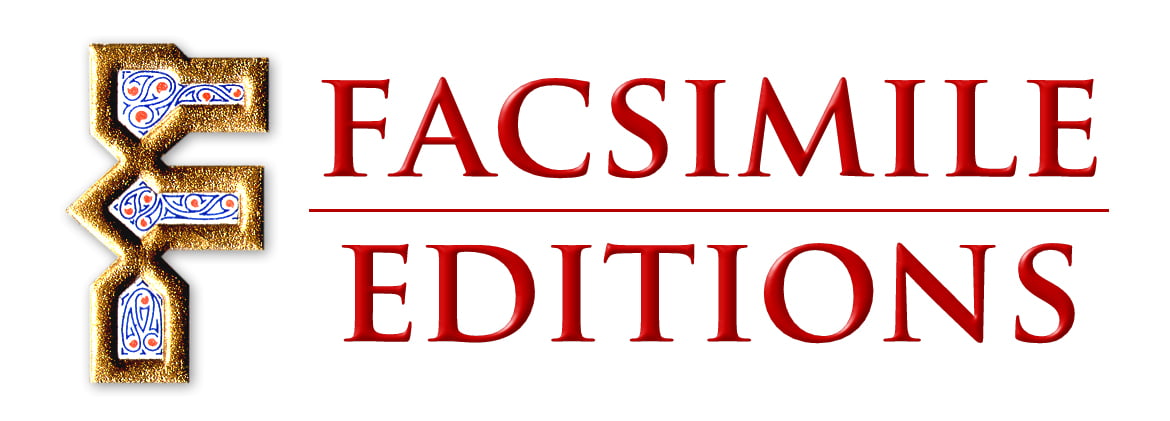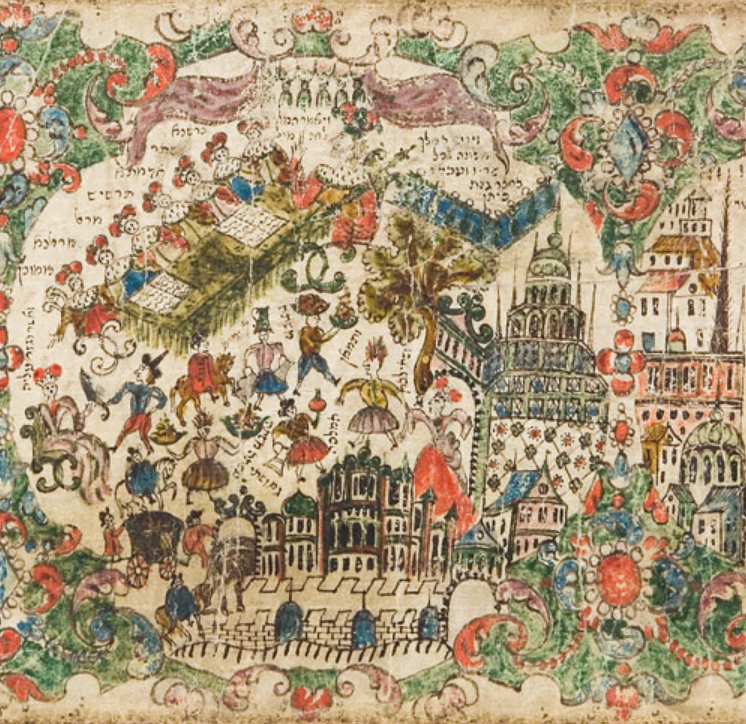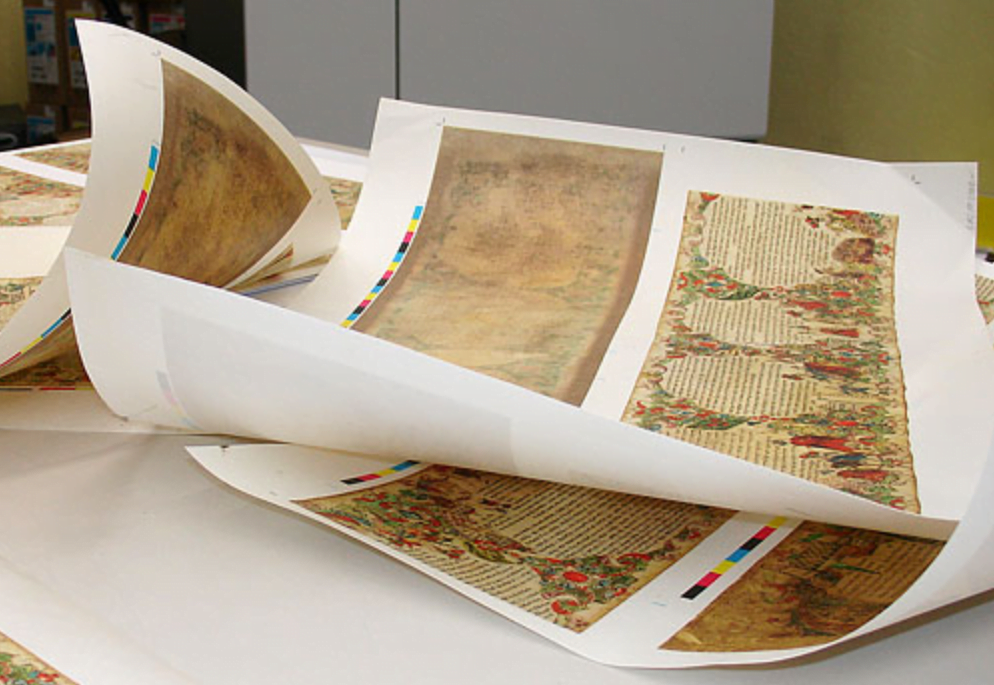
Over the centuries, Esther scrolls have become a symbol of celebration and continuity of Jewish life and they form the core of several major collections. The Gross family in Israel owns one of the finest collections in the world and they allowed their most treasured illuminated megillah to be reproduced in a fine limited edition.

There are scenes of baroque buildings and genteel characters in typical eighteenth-century dress; even Haman’s sons hang in droll positions from the gallows. The wealth of detail contained within the intricately-drawn buildings and costumed figures adds weight to the theory that it was written in Germany around 1700.
Although the exact date and location that the manuscript was commissioned remains a mystery, the words ‘STATT SHUSONN’ written in Latin letters above one of the illustrations at the beginning of the scroll reinforce the German provenance of the manuscript. Only one other Esther scroll, in the Library of the Jewish Theological Seminary in New York, is known to make use of Latin letters, and was written by the same scribe.
This megillah is unique in other ways too. The varying shapes of the eighteen text panels (18 is the numeric value of the Hebrew word Chai, meaning life), none of which are identical, indicate that unusually the text was written after decoration.
It is known that the manuscript was in Vienna in the late 1920s (an illustration appears in the 1928 issue of Menorah published in Vienna) and came into the collection of Eliahu Sachar, the first Israeli ambassador to Austria, around 1950. He brought it to Israel and later sold it to an American collector. The manuscript eventually returned to Israel where it is today in the Gross Family Collection.
The Idea
Muzi Wertheim, a friend of the publishers and collector of Facsimile Editions’ works, proposed the idea to create a facsimile Megillat Esther. It was an idea that the Falters had considered but it was Muzi Wertheim’s enthusiasm and energy that finally brought the project to life.
While Facsimile Editions have worked with silversmiths in the past, they had never made a silver objet d’art and considered it a fine and exciting project to celebrate twenty-five years of publishing.
Muzi Wertheim’s close collaboration with the silversmith has resulted in a replica of extraordinary accuracy.
The Gross Family Collection
William Gross started collecting at the age of six and his extensive collection, focused on the field of Judaica in all its aspects, contains objects, books, manuscripts, reference literature, old postcards and even postage stamps with Jewish connections. They are part of what he calls his ‘window theory of Judaica’ through which we can view and learn about Jewish life of the past. This megillah provides an especially rich view.
The Gross Family Collection
William Gross started collecting at the age of six and his extensive collection, focused on the field of Judaica in all its aspects, contains objects, books, manuscripts, reference literature, old postcards and even postage stamps with Jewish connections. They are part of what he calls his ‘window theory of Judaica’ through which we can view and learn about Jewish life of the past. This megillah provides an especially rich view.
The Facsimile
Introduction
Every facsimile project presents a raft of new challenges, but this scroll demanded the development of so many innovative techniques that it would have deterred all but the most dedicated of publishers.
Craftsmen from England, Israel and Italy worked to combine the latest digital technologies with the age-old processes of parchment-making and lost-wax casting. The result is a facsimile which, according to the manuscript’s owner William Gross, is virtually indistinguishable from the original. And because the materials used are parchment and sterling silver, the facsimiles look and feel exactly the same as the originals, and should last just as long.
Photography
Excellent photography is the key to accurate reproduction. David Harris in Jerusalem worked with Facsimile Editions for nearly twenty years – he photographed the Rothschild Miscellany and Alba Bible manuscripts – and photographed the manuscript with digital equipment.
Colour Separation and Proofing
Great attention was paid to the delicate colours, including the stains which give the facsimile the character of the original and contribute to the unique quality for which the publishers have gained world renown. Proofs on parchment were prepared by the Milanese team of colour separators who have worked on our facsimiles since 1980. These proofs were then compared to the original manuscript in Israel, corrected where necessary and re-proofed in Italy and Israel until the colours exactly matched the original.
Parchment
The parchment is hand-made in England, as it has been for generations, by one of the world’s finest parchment makers. It takes roughly two months to prepare each skin. The Falters personally chose the skins to closely match those used by the original scribe.
The long manufacturing process is highly labour intensive. Hair is first removed from the sheepskin which is then scraped before being washed and softened in vats of lime. The soft clean skins are then fixed to frames and repeatedly wetted, scraped and stretched until a smooth, even finish has been achieved. When dry, the skins are cut from the frames into sheets and sanded. The skins are then graded and only the very best are selected.
How our parchment is made
Parchment Making 12
The parchment is taken for final finishing: hand-sanding to a silky-smooth finish…
Parchment Making 12
The parchment is taken for final finishing: hand-sanding to a silky-smooth finish…
Parchment Making 12
The parchment is taken for final finishing: hand-sanding to a silky-smooth finish…
Printing
High definition colour printing on natural parchment is an extremely complex, costly and lengthy process.
Being a natural substance, parchment is sensitive to the slightest change in humidity. The printed sheet reacts immediately to the ‘wetness’ of the ink and the difference in humidity between the warmer air inside the printing press and the cooler air outside. This does not happen with paper and makes printing on parchment very difficult. It has taken nearly two years to develop new techniques to enable us to print with confidence on parchment.
Reproduction
After printing, the sections are glued together as the original manuscript was in order to make one long parchment (approximately 1.7 metres – 5½ feet) containing the entire text. Finally, the completed parchment is attached to the central winding spindle at one end and the ‘puller’ at the other end before winding back into the case. The scroll is reproduced at 1.17x original size.
Sterling silver hand-made scroll case
The Gross collection’s fine silver megillah case, made by Lorenz Pfalzer in 1824 in Vienna, Austria was perfect for a megillah of this importance. This particularly delicate and elaborate style of case was favoured by Viennese silver workshops for nearly 80 years until the end of the 19th century.
A Russian silversmith living in Israel copied the original case by hand. Renowned for his fine craftsmanship, he was commissioned to make all 295 cases. Working in sterling silver he cast, finished and polished each one by hand. Each case is hallmarked and individually numbered, and the edition is accompanied by a signed and numbered certificate.
The result is a lavish work of art which will be treasured for generations to come.
Edition
The edition is strictly limited to 295 numbered copies. The number of each facsimile is discreetly blind-stamped on the silver case and every facsimile is accompanied by a certificate verifying its number and the size of the edition.
At the completion of the edition, the printing plates and moulds were destroyed thus protecting the significant investment value of each copy.
Hallmark
Once completed, the silver cases were submitted to the Standards Institute of Israel where they were tested, issued with a Certificate of purity and hallmarked. During this process a randomly selected number of cases were given a full Assay during which they were destroyed in order to establish beyond doubt the purity of the silver. Testing comprises a number of stages:
Read more
1 – In the ‘touch’ testing process, the cases are lightly rubbed onto a ‘touchstone’, leaving a thin smear of material on the stone. Chemicals are applied to the smear and from the reaction that takes place, an initial indication of the fineness is determined.
2 – Each case is X-rayed by fluorescence spectrometer which is used to determine the precise fineness of the silver used in making the case. The machine works by firing an X-ray beam which interacts with the case which gives out its own characteristic X-rays. These can be detected and used to determine the composition of the case. The technique is very accurate and non-destructive.
3 – Finally, one or two cases are selected at random for Assaying using the titration process. In this process a silver sample is weighed accurately, placed in a beaker and a fixed quantity of nitric acid added to form a silver nitrate solution. The beaker is placed into an autotitrator where a sodium chloride (common salt) solution is added in known quantities. The sodium chloride reacts with the silver nitrate solution to form silver chloride and the reaction is monitored using an electrode connected to a computer. From the electrode response, it is possible to tell when all of the silver has reacted and thus how much of it must have been present. A weight of pure silver can thus be calculated. Titration produces an accuracy of about 1 part per thousand.
4 – Once the cases have been assayed successfully, they can be marked. The most traditional method of marking is hand marking where the case is marked by striking it with a punch containing the SII symbol.
Commentary Volume

Emile Schrijver, Curator of the Bibliotheca Rosenthaliana (Amsterdam University Library, Netherlands) and specialist in eighteenth-century Hebrew manuscripts and printed books, and Falk Wiesemann, Professor of Modern History at the Heinrich Heine University (Düsseldorf, Germany) and specialist in German Jewish history and folk art, take the reader on an illustrated guided tour through the megillah. Careful reading of the text of the biblical book of Esther is used as the basis for a discussion of the scroll’s illustration cycle which closely follows the Biblical text and can only be really understood and appreciated when simultaneously compared with the text.
The authors intersperse their introduction with discussions of the materials used for the creation of the scroll, the nature of the Hebrew script used, the localization and the dating of the scroll, the delicacy of the silver case and the question of what came first, the text or the images. They also provide, both through historical elaboration and additional black and white images, additional background information on the iconography of the scroll, parallel themes and motives in other scrolls, the printed sources behind the illustrations, customs pertaining to the Purim festival, and the cultural background of the scroll’s assumed patrons.
The commentary volume highlights the literary quality of the Biblical Book of Esther, its importance to the festival of Purim and its significance in Jewish art leaving the reader with an understanding and appreciation of the artistic quality and cultural background of the megillah and its delicate silver case.
The commentary volume is introduced by Muzi Wertheim.
William Gross describes the significance of the manuscript to the Gross Family Collection.
The commentary volume is edited by Jeremy Schonfield, Mason Lecturer, Oxford Centre for Hebrew and Jewish Studies.
Other Custom Projects you may enjoy
Horological Archive
Collection of the world’s leading watch designer’s images for Fondation de la Haute Horlogerie. Geneva, Switzerland
Copper Scroll
1st century Copper Scroll reproduced in copper with patination to match the original for the Museum of the Bible, Washington, USA
























